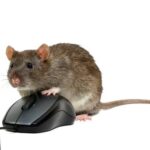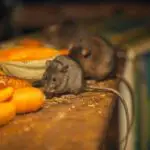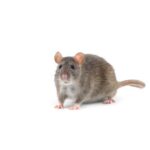Mice Droppings Decoded: Signs and Solutions for Homeowners
Introduction to Mice Droppings
Have you ever stumbled upon small, dark pellets scattered inconspicuously in a corner of your home and wondered how they got there? More often than not, you’ve just had an encounter with mice droppings, a telltale sign of uninvited furry critters in your living space. Recognizing these signs is more than a matter of housekeeping; it’s crucial for the well-being of your family. These little pellets are more than just a nuisance—they carry health risks that can’t be ignored.

Consider Jane’s story. She noticed droppings in her pantry but brushed it off as a one-time sighting. It wasn’t until her family started experiencing mysterious flu-like symptoms that she connected the dots. Medical experts pointed to conditions such as hantavirus—a severe respiratory disease transmitted through rodent droppings. The presence of mice droppings had been the red flag waving right under her nose, highlighting an underlying infestation that put her entire household at risk.
It’s stories like Jane’s that underline the importance of taking immediate action at the first signs of mice droppings. These small but significant indicators can lead to the discovery of a much larger issue: an infestation that if left unchecked, could compromise the health and safety of your living environment. So let’s decode the mystery behind these droppings and equip you with the know-how to keep your home rodent-free and your family protected.
Identifying Mice Droppings
Upon discovering unwanted little house guests, it’s crucial to understand the calling cards they leave behind—specifically, their droppings. After all, distinguishing between mouse poop and the calling cards left by other pests is the first step in targeting the right rodent. Mouse droppings tend to be small, about the size of a grain of rice, with pointed ends and a slight curve—quite similar to a crushed black sesame seed for kitchen aficionados! Notably, you’ll typically spot them where these critters frequent, such as near food sources or nesting sites.
Imagine rummaging through your cereal cupboard or investigating behind your not-so-trusty toaster and stumbling upon what appears to be a sprinkle of dark grains of rice. That’s your first red flag. With other pests, such as roaches or rats, there are differences in shape and moisture content. For a more exhaustive investigation into the similarities and differences, check out this comprehensive guide on how to identify mouse poop from other pests’ droppings. Mouse droppings, for instance, are pointed at the ends and usually found clustered together.
A tell-tale sign of a mouse’s presence is the location of these droppings. Unlike the breadcrumbs in Hansel and Gretel, these little black deposits are often found along walls, in drawers, cabinets, or even under sinks. And if you’re up for a bit of detective work, they can lead you to the mice’s headquarters. Kitchens and pantries are rodent hotspots, but don’t overlook the possibility of them turning your attic or basement into a mouse motel!
Of course, if the droppings left you bamboozled, visual aids always help. Below, find an insightful video that can clear the mysterious mist around mouse poop identification. The more you know, the better you can prepare for the uninvited squatters!
Don’t fret if this all seems overwhelming—it’s a situation many homeowners face, and there are dedicated resources that can assist in reclaiming your home. If you’re pondering proactive measures or need to address an existing furry fiasco, consider exploring these effective strategies for a pest-free home. Remember, the key to maintaining a mouse-free home is not just about the one-time fix; it’s about a comprehensive approach to pest management.
Identifying Mice Droppings
Embarking on the less-than-glamorous journey of distinguishing mouse droppings from other household critters’ contributions? Well, buckle up! Mouse droppings are like unwanted little black rice grains that pop up exactly where you wish they wouldn’t—think kitchen counters, drawers, or the no-man’s-land under appliances. Not exactly what you want to find when reaching for your morning cereal.
Mouse droppings have a distinctive look: they’re about the size of a grain of rice, pointed at the ends, and you’ll usually find them amassed like a tiny, nefarious treasure hoard. A good comparison for the home DIY’ers? They’re much like a dark chocolate sprinkle, only far less appealing on your cupcake!
These little black clues are often tucked away in your cozy home corners or along the paths commonly strolled by these night-time nibblers. If you’ve spotted these signs near your cereal boxes or snack pantry, you might have a mouse problem on your hands. For an in-depth look at distinguishing these droppings, here’s an external resource that dives into the specifics: How to Identify Mouse Droppings.
Now, if you’re a visual learner and need to see to believe, check out this handy video. It’s a masterclass in spotting the difference, armed with which you could practically earn a Ph.D. in Pest Poop Sciences!
But remember, my intuitive homeowners and renters, identifying the poop is merely the first step. Once you confirm the presence of these furry freeloaders, it’s time to strategize your next move. To embark on a triumphant quest for a rodent-free residence, leap over to this page for some top-notch, tested-and-true pest control solutions.
Health Risks Associated with Mouse Feces
When it comes to understanding the unseen dangers lurking in those tiny, seemingly harmless pellets that mice leave behind, it’s important to realize that mouse feces are not just an unsightly nuisance but a potential health hazard. Unpacking the risks involved with mice droppings is a bit like decoding a message about our well-being that we didn’t realize was being delivered right to our doorsteps—or more literally, our kitchen counters and pantry floors.
One of the clandestine culprits carried by mice droppings is hantavirus, a severe respiratory disease that has been known to sweep through households with the stealth of an evening shadow. Imagine this: a family decides to clean out their seldom-used garage. Brushing away the dust and debris, they unwittingly stir up the dried feces of a past rodent visitor, sending particles into the air. Inhaling these infected particles could land them in the hospital with flu-like symptoms that escalate alarmingly fast.
Salmonellosis: A Tiny Particle, A Big Problem
Moving on to another unseen adversary, salmonellosis, we uncover how a microscopic particle from mouse feces can lead to a mighty bout of sickness. Envision a mouse, scurrying across your kitchen work surfaces at night, accidentally sprinkling a trail of contaminated matter as it goes. The next morning, you prepare breakfast, oblivious to the invisible threat. Soon after, your body retaliates with all the classic signs of salmonella poisoning: intestinal upset, fever, and chills.
Don’t Sneeze at Allergies
And it’s not just these diseases we have to be wary of. Allergies, too, can flare up in the presence of mouse feces. Perhaps a friend pops over for coffee and reaches for a mug from your cabinet, not realizing that a family of mice has taken up residence behind your dry goods. Within minutes, sneezing and itchy eyes begin, ruining what should have been a cozy chat over a warm drink.
Safe Cleaning: Your Shield Against Disease
These real-life scenarios underscore the critical importance of safe cleaning practices. Don’t be deceived by the diminutive size of mouse feces. Suiting up with gloves and a mask, ensuring proper ventilation, and wetting down areas before cleaning can mean the difference between health and harm. Enacting these simple but effective measures can protect your household from the unseen menaces that might otherwise go unnoticed until it’s too late.
To gain a further understanding of the relationship between rodents and our health, let’s take a moment to watch an informative video on the matter.
Cleaning and Disinfecting After Mice
Have you come across those tiny, pellet-like evidence that uninvited furry guests have been scurrying around your home? Mice droppings are not only a nuisance but also a health hazard, and cleaning up the aftermath requires a keen and cautious approach. Grab your gloves and masks, because it’s time to dive into the world of hygiene warfare and reclaim the cleanliness of your dwelling!
Step 1: Suit Up for Safety
Before you charge into battle against the remnants of rodent residency, arm yourself with the appropriate armor. Donning thick gloves, an N95 respirator mask, and even protective eyewear can shield you from harmful allergens and possible hantavirus transmissions found in mice droppings. Think of it as dressing up for a messy DIY project – only your health is on the line!

Step 2: Ventilation Is Your Ally
Before wiping out the evidence of the tiny trespassers, let fresh air circulate by opening windows and doors. This not only clears the air of potential pathogens but also makes the cleaning process less suffocating. Imagine the spring breeze as your backup, sweeping through to assist in the eviction of unwanted microbial tenants.
Step 3: The Preliminary Pick-Up
Now, don’t jump straight to the mop and bucket. Using a disposable towel, gently pick up the droppings—no sweeping or vacuuming just yet, as that can send viruses airborne. Just like you’d remove the chess pieces before wiping the board, you must get rid of the solid evidence before the deep clean.
Step 4: Disinfectants – The Silver Bullet
With the invaders’ breadcrumbs out of the way, bring out the big guns—a disinfectant. Bleach is your friend here, but if you prefer to keep it eco-friendly, there are green alternatives that are just as lethal to germs. Spritz and let it sizzle; this isn’t just about aesthetics but ensuring every last microbe knows it has overstayed its welcome.
Step 5: The Final Fortress Cleanse
After the disinfectant has had a chance to work its magic, it’s time for the wipe down. Use disposable towels to clean the surfaces, then toss them as you would a toxic secret. Once the area is clear of disinfectant and droppings, feel free to bring out the vacuum. Finally, the coast is clear for a thorough sweep-up! It’s like erasing the last traces of a chalk drawing, bringing back the pristine state of your home.
Remember, the key to a mice-free home is not just in the cleanup but also in prevention. Check out these effective strategies to banish mice for good, ensuring that once your home is spotless, it stays that way.
Embarking on this cleaning mission might seem daunting, but following these steps ensures a safe and comprehensive purge of pesky mouse by-products. Equip yourself, be thorough, and in the end, relish in the triumph of reestablished hygiene and peace of mind.
Preventing Future Infestations
Ever walked into your pantry, craving a midnight snack, only to find a tiny nibble taken out of your favorite granola bar? That’s right, unwanted furry guests! So, how do we ensure that the only guests sneaking snacks at night are the ones we actually live with? Let’s dive into a homeowner’s guide to mice-proofing your abode!
Seal the Deal: Entry Point Exclusion
Think of mice as the ninjas of the rodent world – they can squeeze through the smallest cracks! To beat them at their own game, it’s time to seal every nook and cranny. That means checking for gaps around windows, doors, and utility pipes. Steel wool and caulking aren’t just for the crafty DIYer; they’re your new best friends for plugging these secret mouse doorways.

Tackling the Clutter Campgrounds
Did you know that your pile of old magazines or that box of holiday decorations hidden away in the attic could be a five-star resort for mice? It’s time to Marie Kondo your space! Mice adore clutter for nest-building, so keeping a tidy house is more than just pleasing to the eye – it’s a strike against rodent residents.
The Art of Storing Snacks
Let’s spill the beans – mice are after our food. That open bag of rice or the cereal box that doesn’t close all the way is a goldmine for these critters. Storing food in airtight containers isn’t just a Pinterest trend; it’s your culinary fortress against pests. And while we’re on the topic of beans, consider the garbage bin—make sure it’s tightly sealed because, for mice, it’s like hitting the jackpot.
If you’re ever grappling with the mice menace, remember that prevention is the best medicine. Take these simple steps to heart, and you can look forward to peace of mind and a rodent-free home!
When to Call a Professional
Discovering mice droppings in your abode doesn’t just provoke an ‘eek!’—it’s a sign, a telltale marker, that you’ve got uninvited rodent roommates. But when do you hoist the white flag and call in the cavalry? Let’s chew through the evidence and unpack when it’s time to pick up the phone for professional pest control.
First off, if your days have turned into a game of “connect the droppings,” tracing a map of tiny, brown pellets throughout your home, it’s a glaring billboard that your DIY traps and peppermint oil aren’t getting the victory royale against these whiskered warriors. Remember, if it’s starting to look like a chocolate chip minefield on your floors, it’s high-time to dial a pro.
What’s more, if you’re hearing the pitter-patter of tiny feet inside the walls at night, or noticing your cereal boxes look like they’ve been through a paper shredder, it’s another level-up in the rodent reality. This isn’t just a cute guest appearance; this is full-scale invasion mode. Your house isn’t just a pit stop; it’s become rodent real estate.
When the signs are this obvious, hiring a pest control professional isn’t just a good idea—it’s a necessity. These experts are the SEAL Team Six of rodent removal; they have the stratagems, the savvy, and the serious firepower (figuratively speaking) to evict your furry foes. They’re armed with more than just cheese traps; think baits, sealants, and infra-red cams that spot Mickey and Minnie’s secret hideouts. And when they’re through, it’s not just about cleaning up the mess—it’s about making sure it’s Fort Knox against any future four-legged infiltrators.
Choosing a reputable pest control service is the Alpha and Omega here. Look for seasoned veterans who come with a dossier of glowing testimonials and a transparent modus operandi. In this battle against the rodents, you want a tried-and-true Colonel, not someone straight out of boot camp. Ask about follow-up services, warranties, and what kind of dark-arts they use to prevent a rodent resurgence—you know, beyond the old-fashioned spring trap.
Got a minute? Here’s a visual that paints a thousand words—a video from a bona fide expert on what you’re up against and how Uncle Sam’s pest control can turn the tides in this whisker war:
Remember, folks, when your home turns into a hotel for rodents, and you’ve gone through all the motions, don’t delay. Call the pest control professionals to kick the gatecrashers out. It’s the surest way to reclaim your castle and bring peace (and cleanliness) back to your kingdom. Because let’s face it, in the epic poem of your home, you want to be the hero—not the one hospitably hosting hordes of hairy hitchhikers!
Frequently Asked Questions
Let’s put on our detective hats and dive into some of the burning questions homeowners have about mice droppings. It’s not exactly dinner table talk, but understanding these tiny clues left behind by our uninvited houseguests is key to keeping our homes rodent-free.
How can I tell how many mice are in my home based on droppings?
If it’s starting to look like your home is a mice clubhouse, droppings can be a big hint. Few droppings generally mean fewer mice. However, if you’re finding little fecal gifts everywhere, it might be time to wave the white flag and call in reinforcements. Imagine one tiny mouse, the size of a fluffy cotton ball, scurrying through your pantry. A lone mouse can produce about 50 to 75 droppings a day. Now, if you see enough droppings to confuse them for sprinkles on a cupcake—well, you get the picture.
Speaking of droppings, how do I tell if they’re fresh or from last season’s mice rave?
Let’s get forensic—fresh droppings are as dark as your morning coffee and as moist as a debated brownie recipe. Over time, they dry out, fade to a crumbly grey, and crumble like chalk. Fresh means you’ve got an active mouse residency, while old droppings might just be leftovers from a past invasion.
Are there any natural mice whisperers that can deter these whiskered intruders?
They say prevention is better than cure, right? So, if you’re looking for a bouncer to keep those mice out, nature’s got your back. You can bet mice aren’t fans of strong scents. Think peppermint oil; it’s like kryptonite to them. A few drops here and there, and you might just have a mouse-free zone. But if you’re dealing with a full-on mice metropolis, don’t just rely on the aroma therapy—seek professional help!
To really get a grasp on what we’re talking about, let’s take a peek at this enlightening video:
Remember, the key to conquering the critter chaos is understanding the signs and acting with a plan. Keep an eye out for these tell-tale droppings and stay one step ahead in the battle for a peaceful, mouse-free home.








